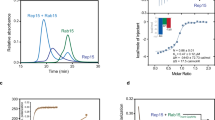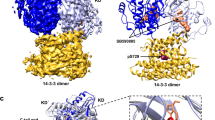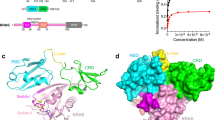Abstract
THE ras-related low-molecular-mass GTPases participate in signal transduction involving a variety of cellular functions, including cell-cycle progression, cellular differentiation, cytoskeletal organization, protein transport and secretion1,2. The cycling of these proteins between GTP-bound and GDP-bound states is partially controlled by GTPase activating proteins (GAPs) which stimulate the intrinsic GTP-hydrolysing activity of specific GTPases1–6. The ras GTPase-activating protein (Ras-GAP) forms a complex with a second protein, p190 (Mr 190,000), in growth-factor stimulated and tyrosine-kinase transformed cells7,8. At its carboxy-terminal end, p190 contains a region that is conserved in the breakpoint cluster region, n-chimaerin, and Rho-GAP9. Each of these three proteins exhibits GAP activity for at least one member of the rho family of small GTPases10. We have tested recombinant p190 protein for GAP activity on GTPases of the ras, rho and rab families, and show here that p190 can function as a GAP specifically for members of the rho family. Consequently, the formation of a complex between Ras-GAP and p190 in growth-factor stimulated cells may allow the coupling of signalling pathways that involve ras and rho GTPases.
This is a preview of subscription content, access via your institution
Access options
Subscribe to this journal
Receive 51 print issues and online access
$199.00 per year
only $3.90 per issue
Buy this article
- Purchase on Springer Link
- Instant access to full article PDF
Prices may be subject to local taxes which are calculated during checkout
Similar content being viewed by others
References
Bourne, H. R., Sanders, D. A. & McCormick, F. Nature 348, 125–132 (1990).
Hall, A. Science 249, 635–640 (1990).
Evans, T., Hart, M. J. & Cerione, R. A. Curr. Opin. Cell Biol. 3, 185–191 (1991).
Lowy, D. R., Zhang, K., DeClue, J. E. & Willumsen, B. M. Trends Genet. 7, 346–351 (1991).
Downward, J. Curr. Opin. Genet. Dev. 2, 13–18 (1992).
Fry, M. J. Curr. Biol. 7, 78–80 (1992).
Ellis, C., Moran, M., McCormick, F. & Pawson, T. Nature 343, 377–381 (1990).
Moran, M., Polakis, P., McCormick, F., Pawson, T. & Ellis, C. Molec. cell. Biol. 11, 1804–1812 (1991).
Settleman, J., Narasimhan, V., Foster, L. C. & Weinberg, R. A. Cell 69, 539–549 (1992).
Diekmann, D. et al. Nature 351, 400–402 (1991).
Trahey, M. & McCormick, F. Science 242, 1697–1700 (1987).
Vogel, U. S. et al. Nature 335, 90–93 (1988).
Otsu, M. et al. Cell 65, 91–104 (1991).
Paterson, H. F. et al. J. Cell Biol. 111, 1001–1007 (1990).
Chardin, P. et al. EMBO J. 8, 1087–1092 (1989).
Adams, A. E. M., Johnson, D. J., Longnecker, R. M., Sloat, B. F. & Pringle, J. R. J. Cell Biol. 111, 131–142 (1990).
Hart, M. J., Polakis, P. G., Evans, T. & Cerione, R. A. J. biol. Chem. 265, 5990–5001 (1990).
Gross, M. et al. Molec. cell. Biol. 5, 1015–1024 (1985).
Trahey, M. et al. Molec. cell. Biol. 7, 541–544 (1987).
Frech, M. et al. Science 249, 169–171 (1990).
Lerosey, I., Chardin, P., deGunzberg, J. & Tavitian, A. J. biol. Chem. 266, 4315–4321 (1991).
Frech, M., Schlichting, I., Wittinghofer, A. & Chardin, P. J. biol. Chem. 265, 6353–6359 (1990).
Garrett, M. D., Self, A. J., van Oers, C. & Hall, A. J. biol. Chem. 264, 10–13 (1989).
Baker, D., Wuestehube, I., Schekman, R., Botstein, D. & Segev, N. Proc. natn. Acad. Sci. U.S.A. 87, 355–359 (1990).
Zahraoui, A., Touchet, N., Chardin, P. & Tavitian, A. J. biol. Chem. 264, 12394–12401 (1989).
McCoy, M. S., Bargman, C. I. & Weinberg, R. A. Molec. cell. Biol. 4, 1577–1582 (1984).
Chardin, P. & Tavitian, A. Nucleic. Acids Res. 17, 4380 (1989).
Tucker, J. et al. EMBO J. 5, 1351–1358 (1986).
Smith, D. B. & Johnson, K. S. Gene 67, 31–40 (1988).
Cicchetti, P., Mayer, B. J., Thiel, G. & Baltimore, D. Science 257, 803–806 (1992).
Author information
Authors and Affiliations
Rights and permissions
About this article
Cite this article
Settleman, J., Albright, C., Foster, L. et al. Association between GTPase activators for Rho and Ras families. Nature 359, 153–154 (1992). https://doi.org/10.1038/359153a0
Received:
Accepted:
Issue Date:
DOI: https://doi.org/10.1038/359153a0
This article is cited by
-
From bench to bedside: current development and emerging trend of KRAS-targeted therapy
Acta Pharmacologica Sinica (2024)
-
Exosomal EphA2 promotes tumor metastasis of triple-negative breast cancer by damaging endothelial barrier
Clinical & Experimental Metastasis (2023)
-
RGS3L allows for an M2 muscarinic receptor-mediated RhoA-dependent inotropy in cardiomyocytes
Basic Research in Cardiology (2022)
-
RhoA: a dubious molecule in cardiac pathophysiology
Journal of Biomedical Science (2021)
-
TC10 regulates breast cancer invasion and metastasis by controlling membrane type-1 matrix metalloproteinase at invadopodia
Communications Biology (2021)
Comments
By submitting a comment you agree to abide by our Terms and Community Guidelines. If you find something abusive or that does not comply with our terms or guidelines please flag it as inappropriate.



